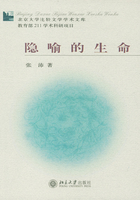
Abstract
This present dissertation makes a comprehensive study of metaphor on rhetorical, poetic, linguistic and philosophical dimensions with the reconciliation between the aesthetic and the cognitive as a point of reference, argueing that metaphor is characteristic o f ontological existence perse.
The first two chapters offer the hub and nub of the whole dissertation.Chapter One serves as an introduction, which deals with the definition of metaphor, its environment, modus operandi as well as its raison d'être.Here the present author contends that metaphor involves a cross-domain mapping and therefore possesses a transforming and becoming identity.
The second chapter deals with the telescoping history of metaphor research in the West and in China. Some may be disappointed at the absence of a comparative study, which is however occasionally realized in the following four chapters.
The third chapter is devoted to the study o f metaphor via rhetoria.Firstly, the author tries to distinguish metaphor from other members in the rhetorical family, such as simile, irony, allegory and metonymy.Considering that rhetoric is an art of persuasion, the perlocutionary function of metaphor is also treated under the head of“metaphoric intimacy”and“metaphor as political-rhetorical exotericism”.The last section, which is to be echoed by the ensuing argumentation, demarcates the cognitive identity of metaphor.
The fourth chapter makes a poetic attack on metaphor.As one of the four distinctive features of literature, metaphor is thought to have affinity with imagery, symbol and mythos.The second part reinforces the relevant contention in the third chapter, arguing that metaphor as a kind of poetic imagination is homogeneous and isotopic to cognitive imagination:cognition in the incipient stage cannot but have resort to metaphoric imagination, while the growing edges of cognition are in turn extended by poetic metaphors.Then we come to the existence of literature.Literary creation is a discourse in which the habitual association between sense and reference is“suspended”, hence a secondary reference, and the latter as the precondition of the virtual mode constructs a self-consistent virtual reality, which unifies the poetic schemata of inner life and the obj ectivity of poetic textures as a metaphor of the real world.This metaphoric reality, though absent prima facie, exists through the reader's metaphoric interpretation.
The fifth chapter yokes the previous part with the forthcoming cognitive study of metaphor by probing into the quarrel and reconciliation between man and language, the dialectic transformation between literal and metaphoric meaning within language proper, as well as the role that double meaning-structure plays in the formation of textual coherence and cohesion.
The last chapter mainly tackles three questions:⑴ the dynamic consanguinity between logic and metaphoric reasoning; ⑵ the metaphoric comparison as a fundamental cognitive method; and ⑶the transforming and becoming nature of life of metaphor.
In the end the author proposes as a possible aim of further study“the Ekstase of metaphoric chaos of life”with a preliminary research as regards the critical instant during the process of metaphoric transformation.